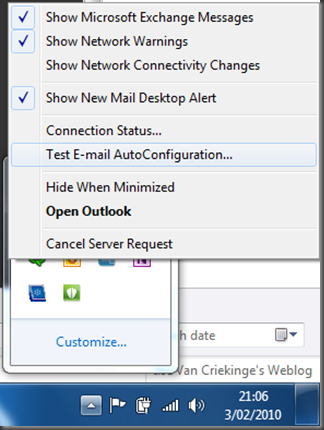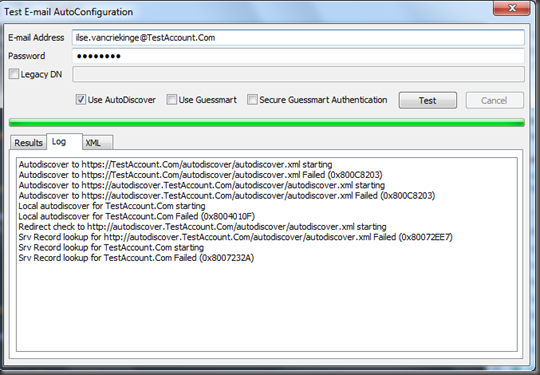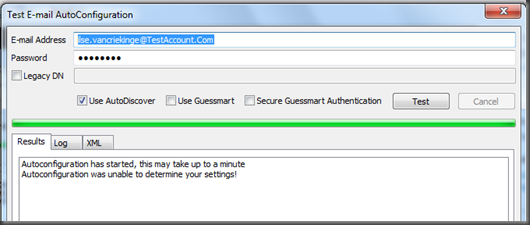some autodiscover fun
I have always loved this feature ever since I first noticed it when diving into Exchange 2007.
For more information about this web service, and how it is used by multiple applications like Microsoft Office Outlook 2007 and later, and the Microsoft Office Communications Server Phone Edition, I would like to refer to this article on MsExchange.Org (Exchange Autodiscover).
In this blog post I just want to highlight how you can change the default behavior of Microsoft Office Outlook when figuring out the Client Access server to connect to use the Autodiscover web service.
Default behavior when launching Microsoft Outlook from a non-domain joined machine (or unable to query Active Directory for the given SMTP address space)
When you launch Microsoft Office Outlook 2007/2010, Outlook will try to connect to a Client Access server using the given e-mail address. Imagine we want to configure a mailbox with a given e-mailaddress Ilse,VanCriekinge@TestAccount.Com.
Outlook will use the given SMTP Domain of TestAccount.com, and try to reach the Client Access server using the following order:
If this fails, the next try will be:
If this fails, the next try will be a local discover of xml files that may contain information on the Client Access server to be contacted.
- Local autodiscover for TestAccount.com starting
If this fails, the next try will be a redirect to:
If this fails, the last step will be to locate a service record:
- Srv Record lookup for http://autodiscover.TestAccount.Com/autodiscover/autodiscover.xml
When holding the Ctrl button, and right-click the Outlook icon in the system tray, you can test the Autoconfiguration and troubleshoot Autodiscover configuration settings.
If this fails, Outlook will not be able to connect to a Client Access server in your environment to retrieve the following pieces of information:
- Exchange 2007
- Internal/External URL for changing UM Settings
- Exchange 2007/Exchange 2010
- Display Name
- Server Name
- Internal/External Connection settings
- Internal/External URL for downloading the Offline Address Book
- Internal/External URL for setting your Out of Office
- Internal/External URL for retrieving Free and Busy information
- Exchange 2010
- Internal/External URL for Exchange Control Panel to change UM Settings
- Online Archive settings
Customizing the default behavior, use local XML
In some cases it might be necessary to change the default behavior or Microsoft Outlook.
An example might be that you have two organizations, sharing the same namespace. Imagine a namespace of ProExchange.Global, shared by both forest A and forest B. When clients login to the domain, they will be services by Active Directory and retrieve the necessary settings. But when trying to launch Microsoft Office Outlook from the outside, there will be one autodiscover record pointing to a Client Access server in Forest A, which won’t help a user from Forest B….
In that situation it might be very useful, if you can help Outlook to query a Client Access server in Forest B directly.
Example situation =
• Situation: Move user x from organization A to organization B.
• Organization A = ProExchange.Global
• Organization B = Sunshine.Edu + ProExchange.Global
• User ivancriekinge has two smtp addresses:
When a user from Organization B, ivancriekinge logs into to the domain itself, there is no problem, since Active Directory will be queried:
When a user from Organization A, administrator logs into to domain itself, there is no problem, since Active Directory will be queried
When user administrator logs in from a non-domain joined machine, there is no problem, since the service record points to a Client Access server in Organization A.
But when user ivancriekinge logs into from a non-domain joined machine, the problem occurs, since the Client Access server in Organization A doesn’t know anything about user ivancriekinge, located in Organization B.
To make user a Client Access server is queried in Organization B, we can use an XML file, which includes the URL to use!
<?xml version="1.0" encoding="utf-8"?>
<Autodiscover xmlns=" http://schemas.microsoft.com/exchange/autodiscover/responseschema/2006" >
<Response xmlns=" http://schemas.microsoft.com/exchange/autodiscover/outlook/responseschema/2006a" >
<Account>
<AccountType>email</AccountType>
<Action>redirectUrl</Action>
<RedirectUrl> https://autodiscover.sunshine.edu/autodiscover/autodiscover.xml </RedirectUrl>
</Account>
</Response>
</Autodiscover>
Then you need to configure the client machine to query that XML file by adding the following registry key:
- Refer to XML file
- for Outlook 2007:
HKCU\Software\Microsoft\Office\12.0\Outlook\Autodiscover
- for Outlook 2010:
HKCU\Software\Microsoft\Office\14.0\Outlook\Autodiscover
STRING_value <your_namespace> = path to XML file
- If you don’t want Outlook to check /autodiscover">https://<SMTPdomain>/autodiscover or /autodiscover">https://autodiscover.<SMTPdomain>/autodiscover first you can force Outlook to use local XML (optional)
- for Outlook 2007:
HKCU\Software\Microsoft\Office\12.0\Outlook\Autodiscover
- for Outlook 2010:
HKCU\Software\Microsoft\Office\14.0\Outlook\Autodiscover
DWORD_value, PreferLocalXML = 1
And then it will work :-)
Any Additional Registry Keys to Use?
Yes :-)
If you don’t want autodiscover to check a few steps, you can include one or more of the following keys.
Outlook 2007:
HKEY_CURRENT_USER\Software\Microsoft\Office\12.0\Outlook\AutoDiscover
Outlook 2010:
HKEY_CURRENT_USER\Software\Microsoft\Office\14.0\Outlook\AutoDiscover
•"ExcludeHttpRedirect"=dword:0
•"ExcludeHttpsAutodiscoverDomain"=dword:0
•"ExcludeHttpsRootDomain"=dword:0
•"ExcludeScpLookup"=dword:0
•"ExcludeSrvLookup"=dword:0
•"ExcludeSrvRecord"=dword:0
Autodiscover is a wonderful feature! Once configured correctly it will save you quite some time!
Ilse











